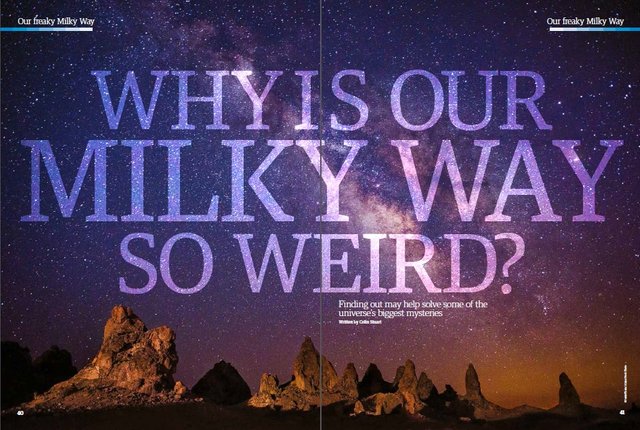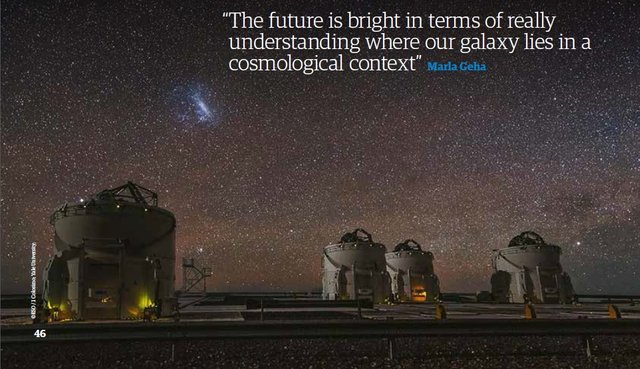WHY IS OUR MILKY WAY SO WEIRD?

Imagine you're marooned deep inside a vast forest. A canopy of trees stretch as far as your eyes can see, and leaves rustle at your feet as you explore your surroundings. Eventually you realise the wood is so big that you can never make it out. Then imagine trying to decipher what the giant forest would look like from the outside and how that compares to other wooded areas far beyond where you an also never travel to.
This unenviable task is similar to the experience of astronomers trying to understand our Milky Way galaxy in the context of the wider universe. At least 100.000-light-years across, and 1.000 light-years thick, we have no prospect of leaving our forest of stars any time soon Thanks to telescopes, we can see into deeper parts of the galaxy. and even glimpse other far off galaxies. but we can never visit those either. So discovering how our Milky Way galaxy compares to others is no easy task - being trapped inside it is both a help and a hindrance. Some things are easier to find out and some things are harder,' says Karen Masters, from the Institute of Cosmology and Gravitation at the University of Portsmouth.
A real benefit is the ability to look at individual stars, measure their chemical abundances and watch their motion around parts of the galaxy. You can dissect the Milky Way in a way that you can't do with other galaxies.' Masters says. Yet learning about the properties of our galaxy as a whole entity can be tough. 'We're out on one side of the Milky Way, so we can see our part of it quite easily.' says Masters. 'but seeing through the galactic centre to the other side of it is very challenging'
Getting over these hurdles really matters. 'We use the Milky Way as a yardstick for the rest of the universe: says Marla Geha. from Yale University. 'If it's not typical then we need to know.' she says. Our knowledge of the Milky Way forms our understanding of the nature of dark matter, cosmology and galaxy formation. Much of this information is gleaned from looking at the relationship between our galaxy and its set of smaller satellites - dwarf galaxies gravitationally bound to the Milky Way and orbiting around it. These include the Large and Small Magellanic Clouds largely visible from only the Southern Hemisphere. Yet Geha's latest research a; Bests that in this department the Milky Way might be more of a freak than we'd previously realised.
Her project - the Satellites Around Galactic Analogs (SAGA) survey - aims to look at 100 galaxies like the Milky Way and study the dwarf galaxies that orbit them That in itself is no mean feat. 'Satellite galaxies look essentially identical to more distant background galaxies,' she says. So how do you tell that you're really looking at a satellite galaxy? By measuring their redshift: says Geha As the universe expands, and the space between galaxies stretches, light travelling through space is also stretched out. This causes the light's frequency to shift towards the red end of the visible spectrum. The further away a galaxy. the more space there is between it and the Milky Way, and more of the light is redshifted on its way here.
Accurately measuring this redshift requires a lot of telescope time, making it very expensive. 'We've been working at this for five or six years now,' Geha says. "and were very proud to have eight Milky-Way-like galaxies with satellites around them.' She was surprised to find that almost all of them showed a fundamental difference to the Milky Way's satellites. 'The satellite galaxies in seven out of eight of the systems were forming stars; she say& In contrast, the Milky Way is a much quieter galaxy; only a small fraction of its satellite galaxies form stars. 'It was a surprise to us,' admits Geha. It seems our galaxy's gravitational pull is stifling star formation in its satellites in a way that similar galaxies aren't. With only eight systems studied so far, the results from the SAGA survey are far from conclusive. But with a larger sample size, astronomers will be able to confirm whether the Milky Way really is as weird as it seems. We might also be able to say more about what our galaxy is doing to halt the creation of new stars in its neighbours.

The SAGA survey could also tell us something interesting about the nature of dark matter - the mysterious and shadowy substance thought to help glue galaxies together. It all hinges on the number of dwarf galaxies Geha and her colleagues find around each galaxy. "If we find that other galaxies have much fewer satellites than the Milky Way there's an argument that dark matter is not cold,” she says. The leading cosmology of today is known as LCDM (Lambda Cold Dark Matter), yet if dark matter is warmer than we think, Geha says it would have acted as an ‘egg beater’, stirring up the early universe and preventing as many smaller galaxies from forming. “We don't have many ways of figuring out the nature of what dark matter is,” she says. “This is one way to get at that.”
Geha's research is just one part of a growing body of evidence suggesting that our Milky Way is somewhat of an oddball, flying in the face of our traditional picture. Our galaxy appears to be a flat disc with spiral arms and its stars – including the Sun – orbit around the centre. That in itself is very run-of-the-mill. Except, from their study of other galaxies, astronomers have noticed a relationship between the speed at which a galaxy's stars rotate and the overall brightness of the galaxy. “There is some indication that the Milky Way isn't as bright [as it should be],” says Masters. Although she also cautions that the data behind this assumption is actually quite scattered.
Masters has been heavily involved in Galaxy Zoo – a citizen science project that enlists the help of members of the public to look at galaxies and help classify them. There are so many images of galaxies these days that astronomers simply cannot get through all of them without assistance. The human eye is much better at spotting patterns and things that are out of the ordinary rather than a computer programme. Among many successes, the project has helped identify the existence of so-called ‘red spirals’ – spiral galaxies with a much lower rate of star formation than typical spirals. After all, we only tend to see spiral arms because they are bright areas of a galaxy's disc picked out by hot, blue, young stars. “The Milky Way is not star forming very actively,” says Masters. So it seems our galaxy might be one of these red spirals. That makes it somewhat of an outlier. “Only ten to twenty per cent of spirals are red,” she says.
That isn't the only thing potentially unusual about the Milky Way's spiral arms. It is thought that our galaxy has a bar structure at the centre, which is where the spiral arms originate from. “Most barred spirals have two arms,” says Masters, “but there's a debate as to whether the Milky Way has two or four spiral arms.” In 2015, astronomers using data from NASA's Wide-field Infrared Survey Explorer (WISE) came out in favour of the four-arm picture. The four proposed arms are called Perseus, Scutum-Centaurus, Sagittarius and Outer. If the Milky Way really does have this quartet then this would be another reason to think of our galaxy as a bit of a misfit.
In the middle of the Milky Way 26,000 light years away, along with its central bar, sits a supermassive black hole tipping the scales at a colossal four-million-times the mass of the Sun Astronomers believe that nearly all large galaxies have this massive beasts at their heart, so nothing out of the ordinary there. It even seems to have the right mass. 'Central black holes tend to be about four per cent of the mass of the galaxy they reside in, and that seems roughly in-line for the Milky Way. says Masters. Yet our black hole - dubbed Sagittarius A (Sgr A') - does seem to be remarkably quiet for a black hole. But Masters wams against getting too carried away. 'There seems to be a cycle where they turn on and off; she says. Back in 2008, a team of astronomers announced they'd found evidence of Sgr A flaring up 300 years ago and in 2014 it was announced that Sgr A' had experienced an increase in flare activity, so is the black hole currently in its more active phase?
It's an exciting time to be involved in black hole research, and the latest instruments could provide a sea of change in our understanding, allowing us to say more about how freakish our central black hole is. Recently, the giant computational telescope - the Event Horizon Telescope (EHT) - made its first observations of Sgr R. The telescope is made by combining the power of radio telescopes across the world. This creates a telescope that is essentially equivalent to the size of the Earth. It is hoped it will provide a close-up view of the black hole's shadow - a dark region where light passing close to the black hole is bent back, but does not 'fall' in and instead bends around the unseen mass The recent discovery of gravitational waves also gifts astronomers yet another way to peer into the darkness and learn about black holes. More data means a higher degree of confidence when comparing our black hole to those at the centre of other galaxies.
That's what it comes down to. We can only really say how freakish our Milky Way is if we're able to observe other galaxies in as much detail as we do our own. Masters is currently involved in the MaNGA (Mapping Nearby Galaxies at Apache Point Observatory) project, part of the Sloane Digital Sky Survey. 'We make these 3D maps of nearby galaxies,' she says. There's also a little side project to make sure they observe as many galaxies as possible that are in a similar mass range to the Milky Way. 'Then well have a better comparison set for these questions about how odd the Milky Way is' Celia agrees that we're heading in the right direction: 'I can't wait,' she says. The future is really exciting and bright in terms of really understanding where our galaxy lies in a cosmological context.'
